
The Bottom Line
The First Custom GTX 1070 We've Tested
Here we are, a week out from my review on the MSI GeForce GTX 1080 Gaming X 8G, our first custom GTX 1080 card. One week later, and we are finally publishing our first custom GTX 1070 review, with MSI's GeForce GTX 1070 Gaming X 8G, a slight bump down from the GTX 1080 - with impressive overclocking headroom, and the same silent gaming experience.
First off, I've done some Facebook Live videos on MSI's GeForce GTX 1070 Gaming X 8G, which we've got embedded below.
As you can see from our Facebook Live videos, there have been some rather excited gamers out there wanting to see what the MSI GeForce GTX 1070 Gaming X 8G is all about. We have had over 500,000+ reached with thousands of views on these videos, and don't worry - I will be doing more of these, for every single video card, monitor, and VR headset I have - or will have coming through my doors.
NVIDIA's new GeForce GTX 1070 is second only to the GTX 1080, with less CUDA cores, GDDR5 versus the GDDR5X on the GTX 1080, and well - that's about it. NVIDIA's own GeForce GTX 1080 Founders Edition video card was an impressive piece of technology, but MSI has really changed things up with its Gaming X line, throwing its always impressive, but new Twin Frozr VI cooler on it - for silent, but powerful gaming.
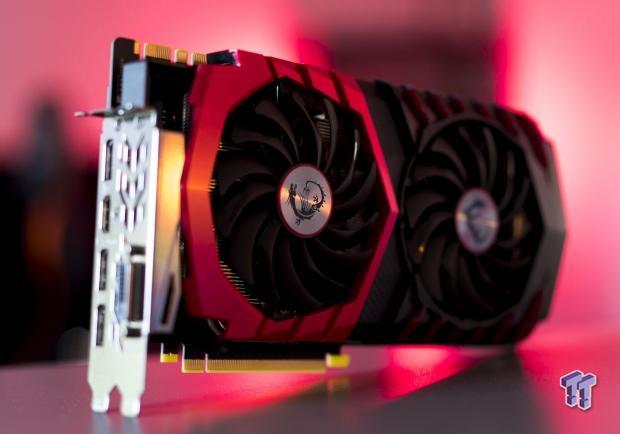
Both the GeForce GTX 1080 and GTX 1070 are made on the same 16nm FinFET process, and both rock NVIDIA's next-gen Pascal architecture. The big difference here is that the GTX 1080 features 2560 CUDA cores, while the GTX 1070 gets cut down to 1920 CUDA cores. It seems like a lot, but will it hurt the performance? We'll have to see.
The GeForce GTX 1070 Founders Edition rocks a Core clock of 1506MHz with a Boost of 1683MHz, with 8GB of GDDR5 on a 256-bit memory bus with the 8GB of framebuffer set at 8GHz. The TDP of the GTX 1070 FE is 150W, but MSI has an additional 6-pin PCIe power connector that should hopefully provide some good overclocking headroom. MSI amps those clock speeds up, which we'll get into below.
The First of a Wave of New GeForce GTX 1070s
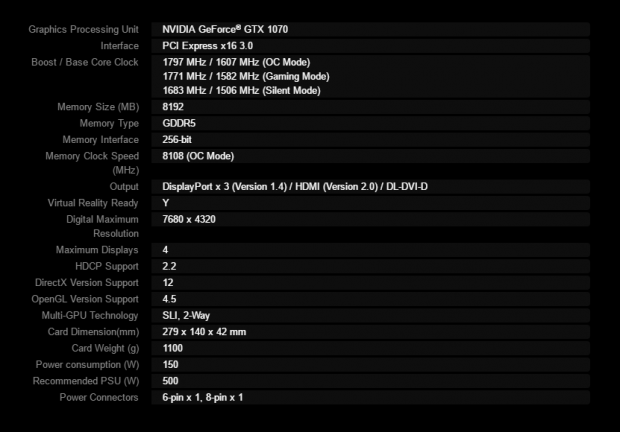
While the GTX 1070 Founders Edition has a Core clock of 1506MHz, the MSI card ships with three different modes - Silent, Gaming and OC. Out of the box, my MSI GeForce GTX 1070 Gaming X 8G was clocked at a huge 2088MHz on Boost... so that explains MSI and ASUS shipping cards to the press with overclocked profiles enabled, or it was my EVGA Precision X OC software - which I used to down clock my card to its Boost of 1797MHz.
Here's what to expect:
- Silent: 1506MHz/1683MHz (Base/Boost)
- Gaming: 1582/1771MHz (Base/Boost)
- OC: 1607/1797MHz (Base/Boost)
We have more GeForce GTX 1070 video cards coming through the labs, including cards from both GIGABYTE and Palit (so far). But, the MSI card has my eye as I was so in love with the GTX 1080 Gaming X 8G, which provided a totally silent gaming experience - all while providing some truly kick ass performance.
MSI's Twin Frozr VI Cooler, Custom PCB, and RGBs
Twin Frozr VI with Torx 2.0 Fans
MSI has proven itself over the years with its video cards, with the Twin Frozr cooler being one of the most popular coolers amongst gamers and enthusiasts. The new GTX 1070 Gaming X 8G has the latest Twin Frozr VI cooler, which we're going to go into detail about now.

In the heart of the Twin Frozr VI are two Torx 2.0 fans from MSI, which allows the Twin Frozr VI to keep the card at very respectable temperatures. Torx 2.0 generates 22% more air pressure and packs silent performance even during those all-night gaming sessions.
The Dispersion Fan Blade has a steeper curved blade which helps with increased airflow, mixed with dual ball bearings provide not only longer-lasting components but they are silent under load - and when we say silent, we mean it. It doesn't matter how many games you throw at the MSI GeForce GTX 1070 Gaming X 8G; nothing will make those fans start making any noticeable noise. An achievement that goes a long way for MSI with its GTX 1070 Gaming X 8G.
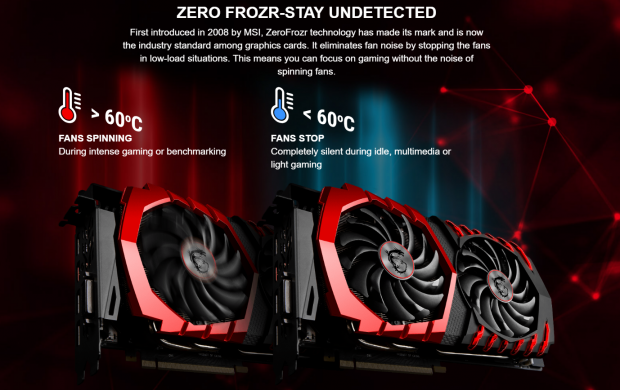
MSI call its Zero Frozr technology an industry standard with video cards, and I have to agree - I've never been disappointed by a Twin Frozr-cooled video card. The GeForce GTX 1070 Gaming X 8G is completely silent when the card isn't being stressed, with the fans not spinning until the card hits 60C. Anything below this is complete silence. Once you hit 60C, the fans will begin to spin up, but even during heavy gaming and benchmarking sessions, the MSI GeForce GTX 1070 Gaming X 8G didn't make a sound. I didn't believe it and began stressing it more and more just to prove the point, and the result is an entirely silent gaming experience.
We can't just have great performance, with some gamers wanting a bit of customizability with their gaming PCs, and this is where the new LEDs come into play. Each LED on the card can be individually controlled, with it being tweaked through MSI's Gaming App. You can have the GTX 1070 Gaming X 8G change its LED effects by the sound of your game, music, or movies with steady lights, breathing and flashing effects.
A Deeper Dive Into Twin Frozr VI

The MSI GeForce GTX 1070 Gaming X 8G is cooled by a massive, and very intricate heat sink, and with its 'advanced aerodynamics' as MSI puts it, it directs air much more directly into the Twin Frozr VI heat pipes. There are even special deflectors on the heat sink that enlarge the surface areas, allowing the card to take in the heat and expel it much quicker that temperatures drop. So much so that when the fans eventually spin up, they don't hit levels where you'll hear them.

MSI has used an 8mm thick copper heat pipe that has a smoothed square shape at the bottom that maximizes the heat transfer from the surface of the copper backplate, where it's better equipped to cool the card down. There's a solid nickel-plated copper baseplate that takes the heat from the GP104 GPU and takes it to the heat pipes so that it can be dissipated across the heat sink, and be cooled down.
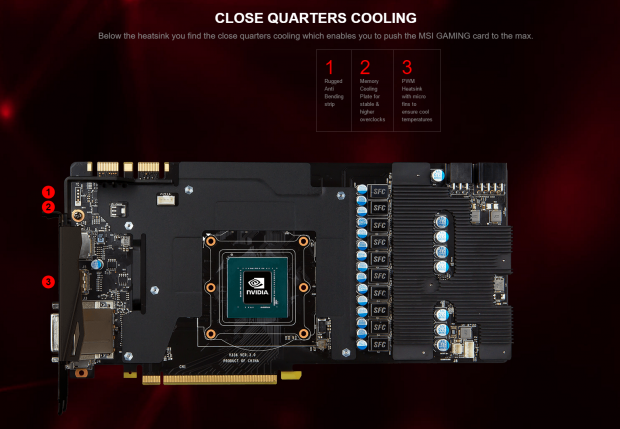
Something else that MSI uses to keep their GTX 1070 Gaming X 8G silent is their 'close quarters cooling', where below the heat sink MSI has used three things to keep the card running everything at 100%, while maintaining the temperatures and noise down. The way they do this is by using a rugged anti-bending strip on the PCB, a memory cooling plate for more stable, and higher overclocks, and a PWM heat sink with microfins to keep the temperatures down.
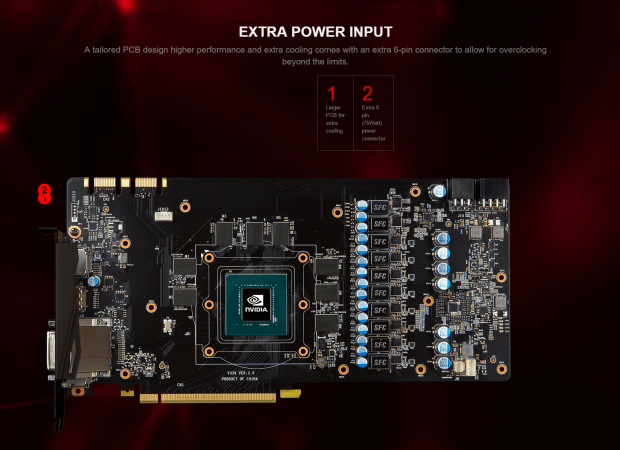
An extra power input is another addition to the GTX 1070 Gaming X 8G over NVIDIA's GeForce GTX 1070 Founders Edition, with a 6-pin PCIe power connector accompanying the 8-pin PCIe power connector. This provides the card with an additional 75W of power over the 180W TDP. MSI has also used a 10-phase PWM design with high-quality, military-class components that provide higher reliability and a potential higher OC with higher stability.

Around the back, MSI has a beautiful backplate that has holes not just for cooling but for aesthetics, with the usual MSI dragon on the right making a mean-looking appearance.
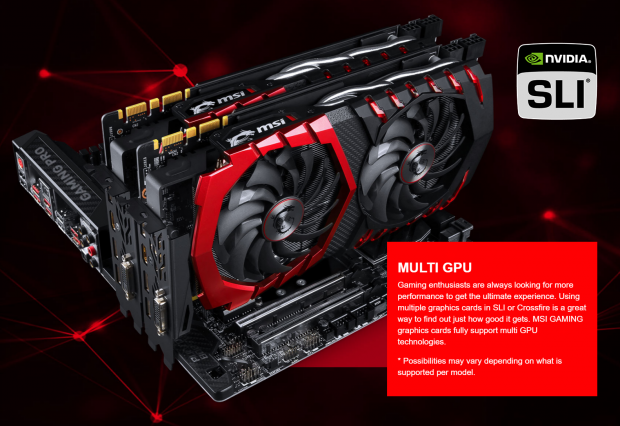
Remember that you can put the MSI GeForce GTX 1070 Gaming X 8G cards in SLI for a huge performance boost, and while we haven't had two of these in SLI just yet, I can't imagine what two in SLI would be like - especially with the thermal and acoustic performance of this card.
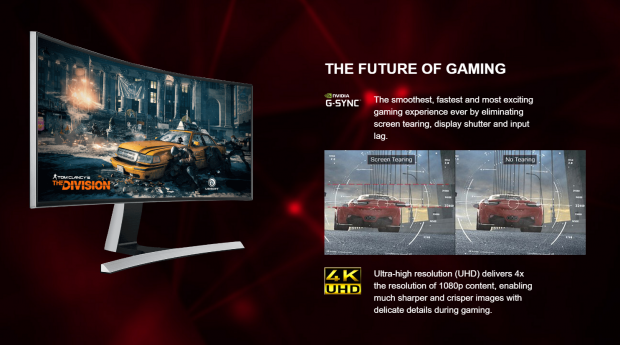
MSI also has support for G-Sync monitors of course, with the latest G-Sync monitors working with the MSI GeForce GTX 1070 Gaming X 8G.
MSI Gives VR Some Love

We have VR support also, with the HTC Vive and Oculus Rift both having support with MSI under the VR Ready program.

On top of that, with the MSI Gaming App, there's a one-click to VR option which primes your gaming PC for VR by setting all of the key components to high-performance settings and making sure that other application on your PC interfere with your VR experience - now that, I love.
MSI's Gaming App is Pretty Packed Full of Features
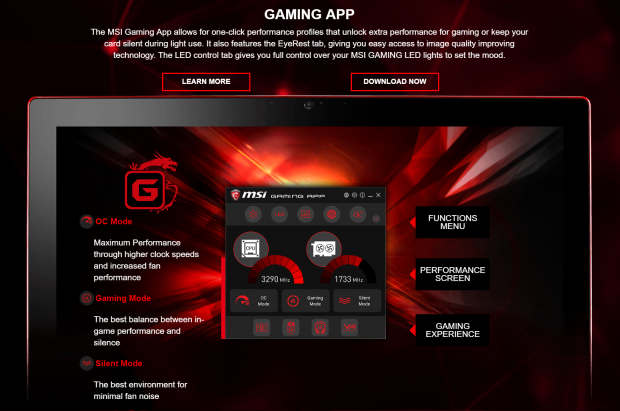
The optional MSI Gaming App is something else that MSI has with its new GeForce GTX 1070 Gaming X 8G, with MSI allowing one-click performance profiles for when you want to start gaming or keep your gaming experience silent during lighter operation. MSI includes the EyeRest tab, which provides improved image quality, with the LED control tab providing full control over the MSI Gaming LEDs.


There's even on-screen speed and temperature overlays, which will provide real-time monitoring of the GPU, DRAM frequency, GPU and CPU temperatures, and more.
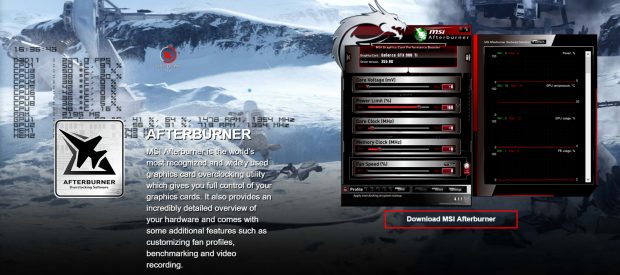
We also can't forget about MSI's overclocking software, Afterburner, which will provide you full control over your video card.
Detailed Look & Specifications
Detailed Look
MSI created a pair of high-performing twins with its GTX 1080 and GTX 1070 Gaming X 8G cards, as they both look absolutely identical. The only way to tell the difference is underneath, with the GTX 1070 rocking 8GB of GDDR5 RAM versus the GDDR5X on the GTX 1080, as well as the reduced CUDA cores on the GTX 1070.
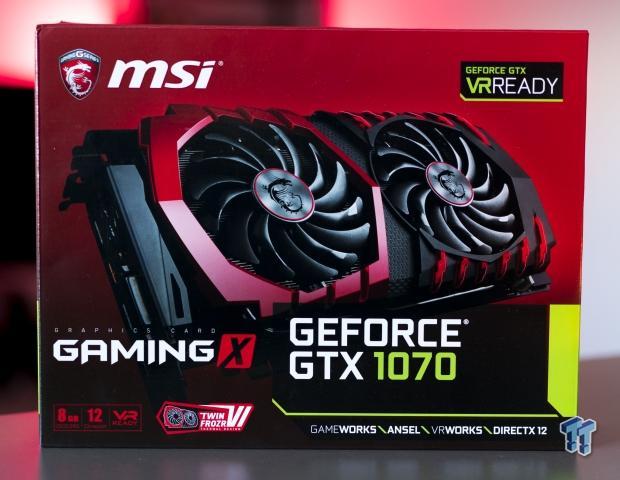
Starting with the front of the MSI GeForce GTX 1070 Gaming X 8G box, is virtually identical to the GTX 1080 variant, with branding for GameWorks, Ansel, VRWorks, and DirectX 12 nice and visible.

On the rear, MSI details its beautiful custom LED lighting, the upgraded, and very silent Twin Frozr VI cooler, MSI Gaming App, and more.

The front of the MSI GeForce GTX 1070 Gaming X 8G is identical to the GTX 1080 card.

The same goes for the rear of the GTX 1070 Gaming X 8G.

The bottom of the card is taken up by a rather large heat sink and heat pipe array.

The heat sink that keeps the GP104 and 8GB of GDDR5 nice and cool extends to the rear of the card, and over the VRMs.

Here we have the top of the card, with the heat pipe array teased.

MSI has added a 6-pin PCIe power connector which is joined by the default 8-pin PCIe power connector.

For display output connectivity, we have the usual 3 x DP 1.4 ports, HDMI 2.0b, and a DVI port.
Specifications
MSI has increased the clocks on both the GPU and the 8GB of GDDR5 on its GeForce GTX 1070 Gaming X 8G, with MSI providing the same three overclocking profiles that it did on its GTX 1080 Gaming X 8G. We have Silent, Gaming, and OC modes - with 1506/1683MHz for Base/Boost clocks on the Silent mode, 1583/1771MHz on Gaming mode, and finally on the OC mode we have 1607/1797MHz.

MSI has also overclocked the 8GB of GDDR5 from its stock frequency of 8GHz to 8108MHz (108MHz overclock) - but this only applies to the OC mode. For the rest of the card, we have 150W power consumption, 3 x DP 1.4 outputs, 1 x HDMI 2.0b and DVI output. The MSI GeForce GTX 1070 Gaming X 8G supports 2-way SLI, as well.
Testing Methodology & Test Setup Configuration
Testing Method
For the purposes of testing the MSI GeForce GTX 1080 Gaming X 8G, and for all future GPU reviews and articles, we've changed up our benchmark suite. I've removed Battlefield 4, GRID: Autosport, BioShock: Infinite, and Grand Theft Auto V. In their place, I've got Far Cry Primal and The Division.
I've also added in some DX12 testing, with Hitman and Ashes of the Singularity. This will provide us with enough variety, but I'm on the hunt for new benchmarks all the time. The second that Battlefield 1 drops, we'll be including that in our GPU reviews, while I'll also be keeping an eye out on the release of Deus Ex: Mankind Divided.
Test System Configuration
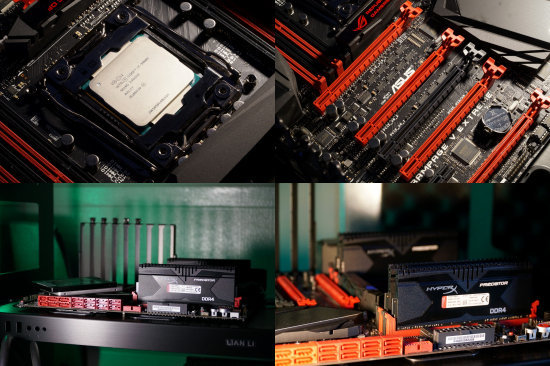
Corsair sent us over their kick-ass AX1500i PSU, which provides 1500W of power for our 3 and 4-way GPU testing that we have coming very soon.
Anthony's Video Card Test System Specifications
- Motherboard: ASUS Rampage V Extreme - Buy from Amazon / Read our review
- CPU: Intel Core i7 5960X - Buy from Amazon / Read our review
- Cooler: Corsair H110 - Buy from Amazon / Read our review
- Memory: Kingston 16GB (4x4GB) HyperX Predator DDR4 3000MHz - Buy from Amazon
- Storage #1: SanDisk Extreme II 240GB - Buy from Amazon / Read our review
- Storage #2: Intel 730 Series 480GB - Buy from Amazon / Read our review
- Case: Lian Li PC-T80 Open-Air - Buy from Amazon
- Power Supply: Corsair AX1500i - Buy from Amazon / Read our review
- OS: Microsoft Windows 10 Home 64-bit - Buy from Amazon
- Drivers: NVIDIA GeForce 368.14 and AMD Catalyst 16.5.2.1 hotfix
Benchmarks - Synthetic
3DMark Fire Strike - 1080p
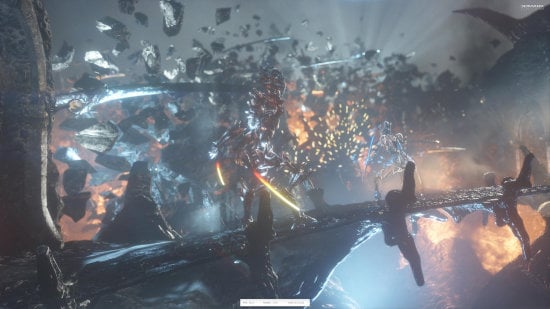
3DMark has been a staple benchmark for years now, all the way back to when The Matrix was released and Futuremark had bullet time inspired benchmarks. 3DMark is the perfect tool to see if your system - most important, your CPU and GPU - is performing as it should. You can search results for your GPU, to see if it falls in line with other systems based on similar hardware.
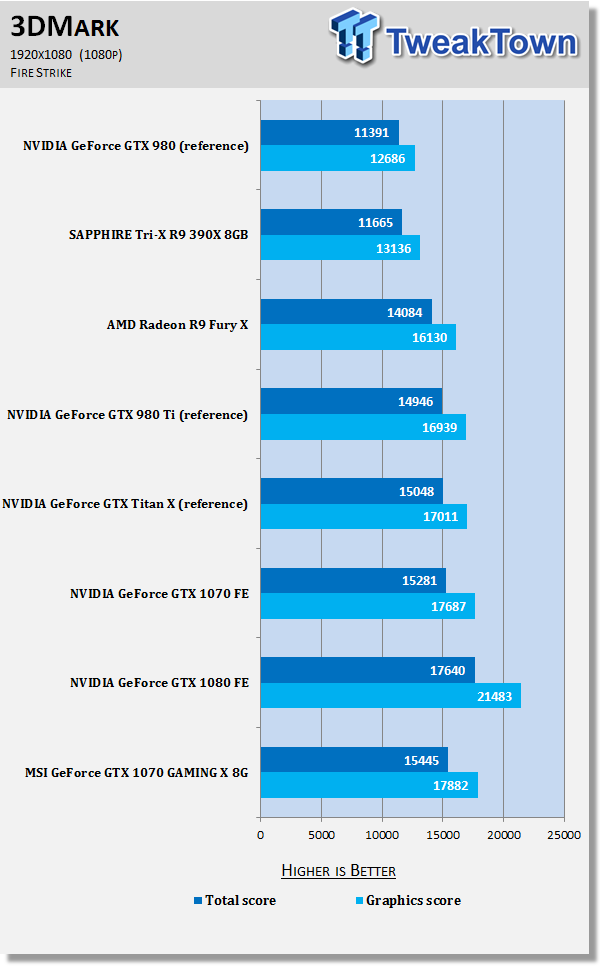
3DMark Fire Strike Extreme - 1440p
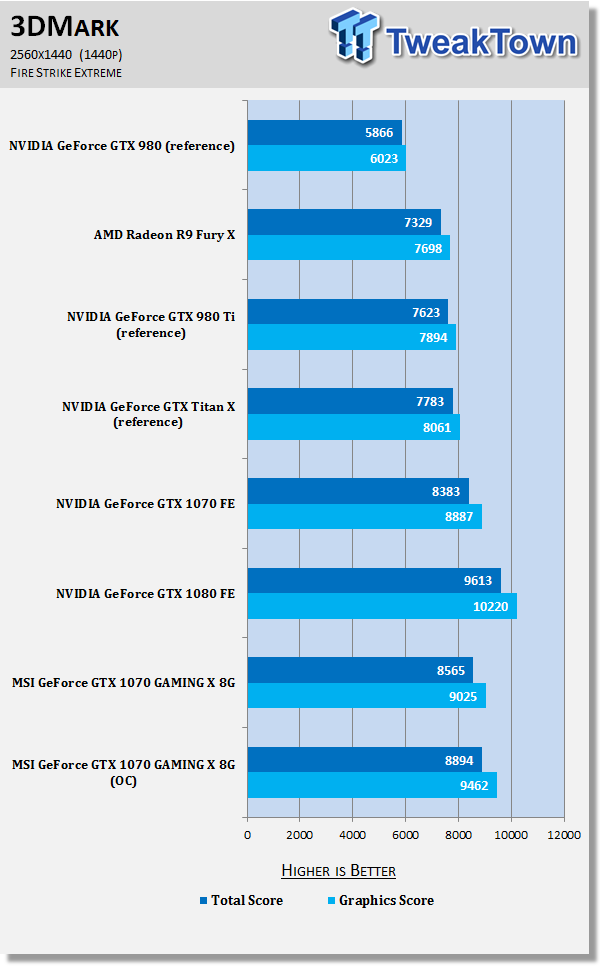
3DMark Fire Strike Ultra - 4K (3840x2160)
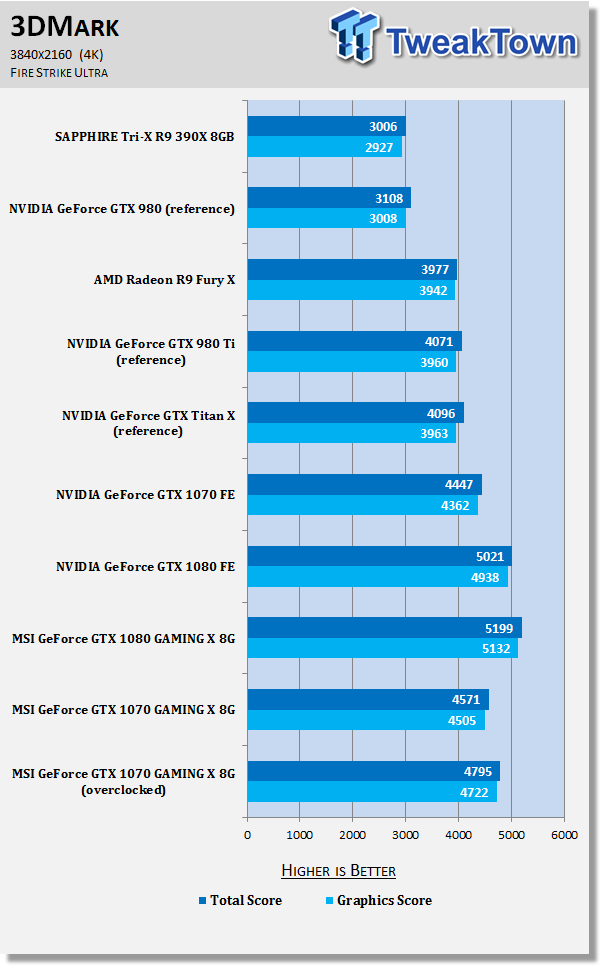
Heaven - 1080p
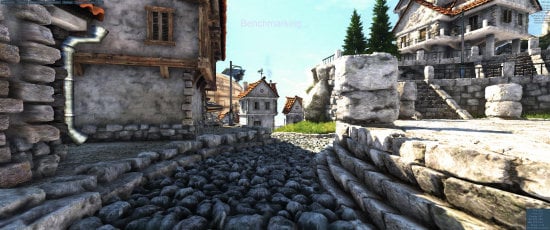
Heaven is an intensive GPU benchmark that really pushes your silicon to its limits. It's another favorite of ours as it has some great scaling for multi-GPU testing, and it's great for getting your GPU to 100% for power and noise testing.
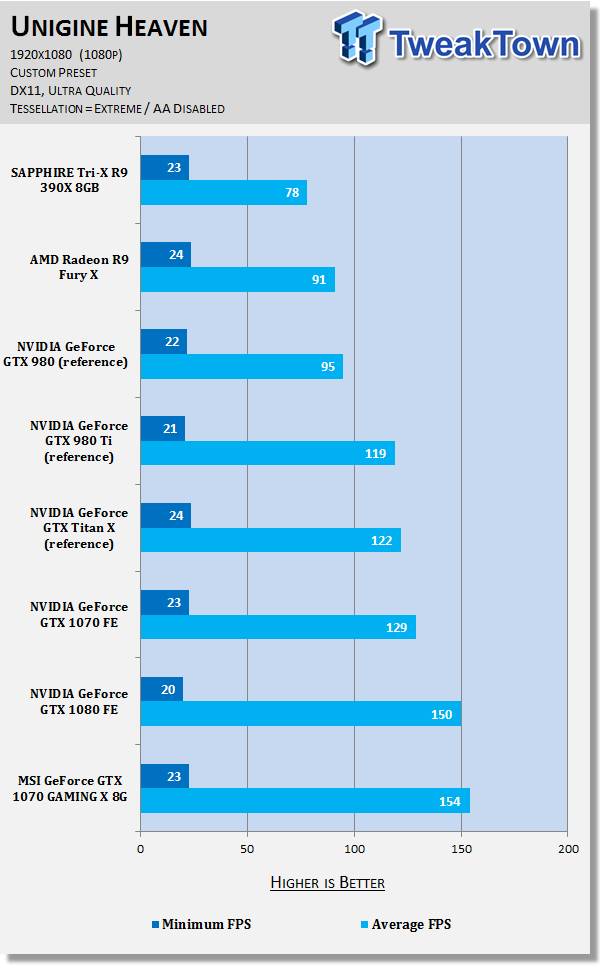
Heaven - 1440p
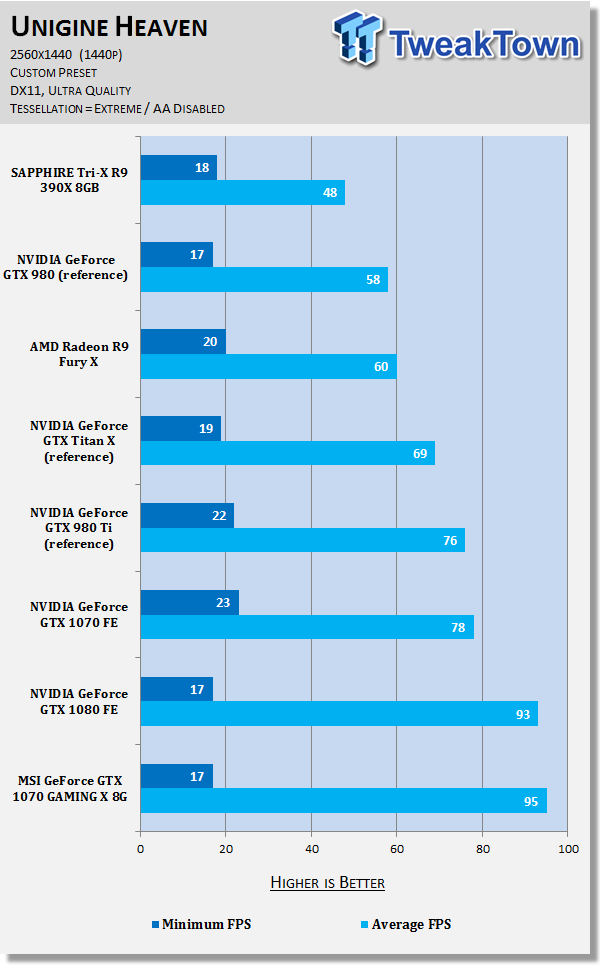
Heaven - 4K (3840x2160)
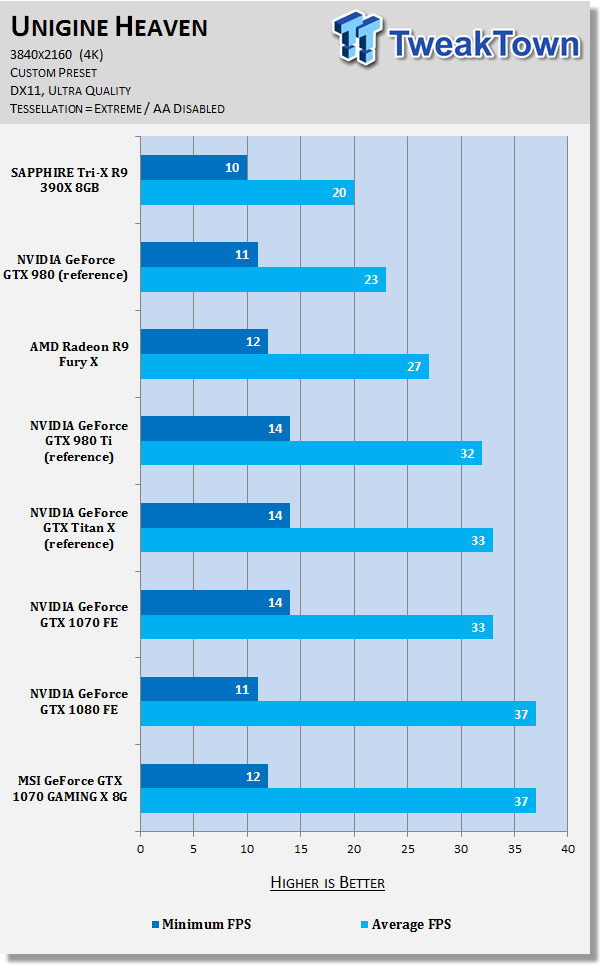
Benchmarks @ 1080p
1080p Benchmarks

Far Cry Primal is a game built on the impressive Dunia Engine 2 with wide open, beautiful environments. It might look stunning, but the performance is actually quite good - but most cards will be stressed at 1440p, and especially so at 4K and beyond.
You can buy Far Cry Primal at Amazon.


Tom Clancy's The Division is one of the best looking games on the market, build with the beautiful Snowdrop engine. It's an RPG, including some awesome PvP multiplayer, and some of the best graphics on the market. It really stresses systems out, especially at 4K, making it perfect to test with our various video cards.
You can buy The Division at Amazon, and you can read our full review here.
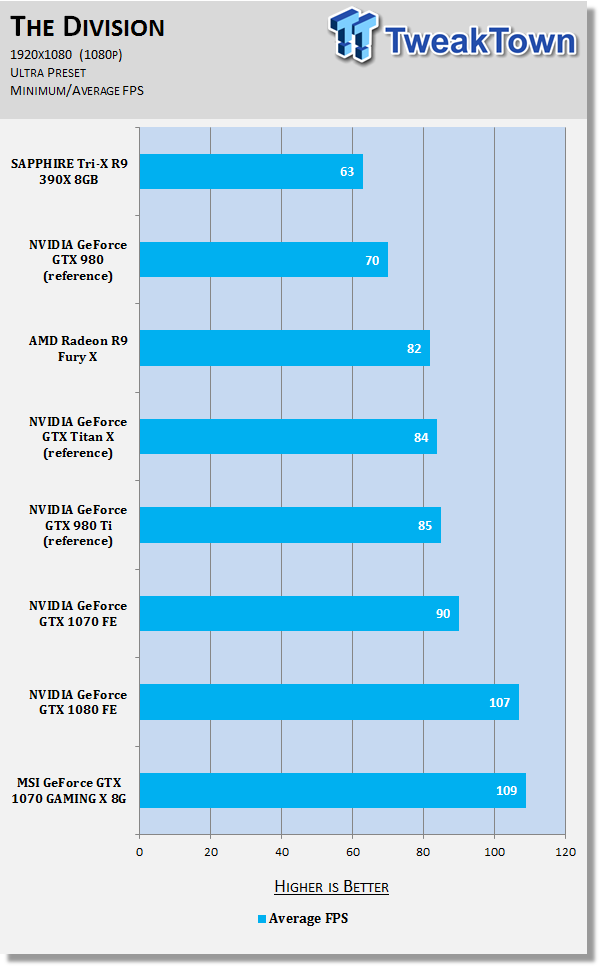

We recently changed over to Metro: Last Light Redux, with developer 4A Games making the Redux version of Metro: Last Light the 'definitive' version of the game. Redux had a fresh coat of paint on the already impressive 4A Engine, and it really pushes our GPUs to their limits.
You can buy Metro: Last Light Redux at Amazon.
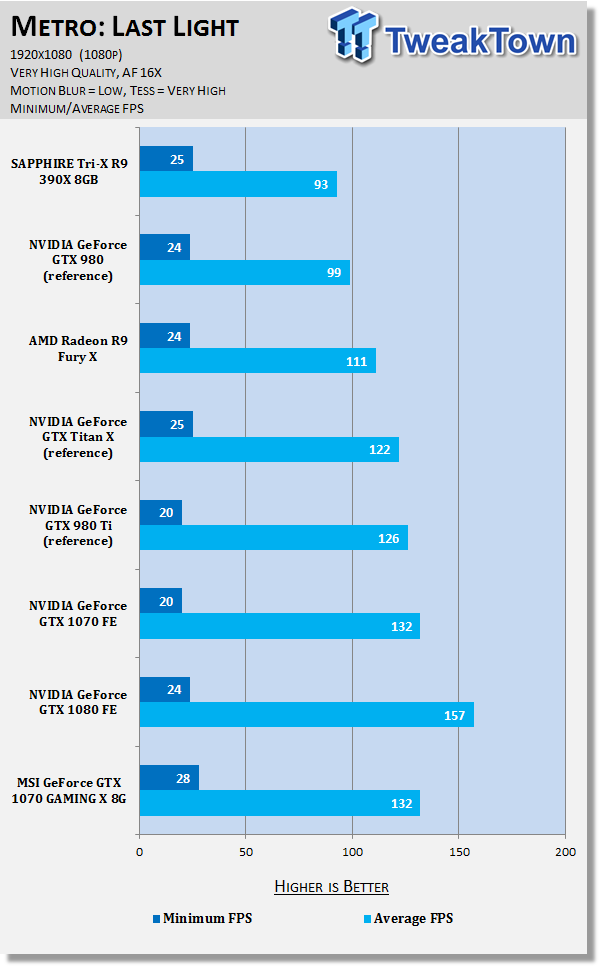

Middle-earth: Shadow of Mordor is one of the most graphically intensive games we test, with Monolith using their own Lithtech engine to power the game. When cranked up to maximum detail, it will chew through your GPU and its VRAM like it's nothing.
You can buy Middle-earth: Shadow of Mordor at Amazon.


Thief has been around for quite a while now, with the latest version of the first-person stealth game powered by Epic Games' older Unreal Engine 3. While it's old, it has some great multi-GPU scaling that we use to test out our various GPU setups.
You can buy Thief at Amazon.
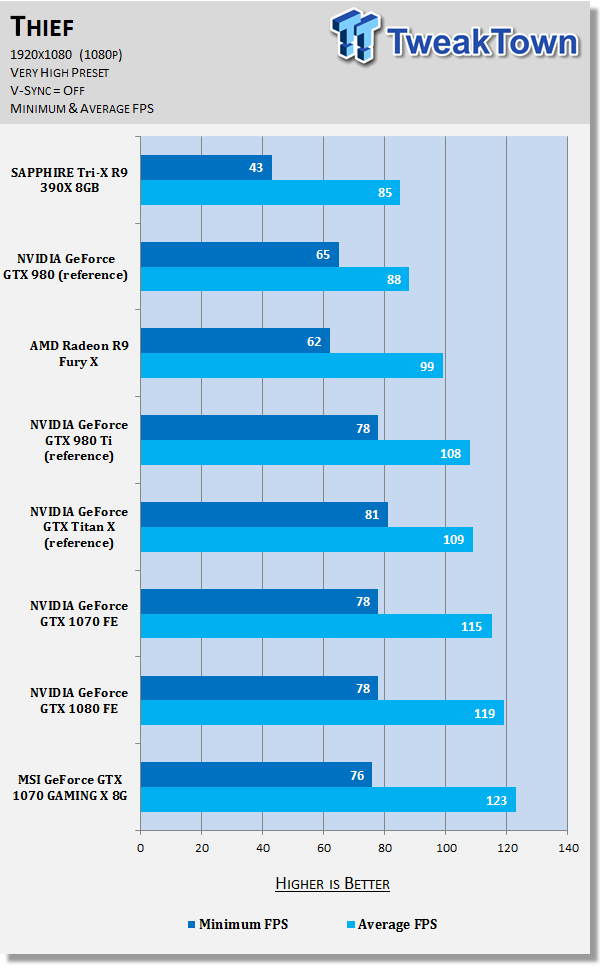

Tomb Raider is still such a gorgeous game, with developer Crystal Dynamics using their own 'Foundation' engine to build Lara Croft into the new world. One of the best parts about Tomb Raider is the absolutely stellar multi-GPU scaling, so this is an important test to see how well our NVIDIA GeForce SLI and AMD Radeon Crossfire setups scale.
You can buy Tomb Raider at Amazon.

Benchmarks @ 1440p
1440p Benchmarks

Far Cry Primal is a game built on the impressive Dunia Engine 2 with wide open, beautiful environments. It might look stunning, but the performance is actually quite good - but most cards will be stressed at 1440p, and especially so at 4K and beyond.
You can buy Far Cry Primal at Amazon.
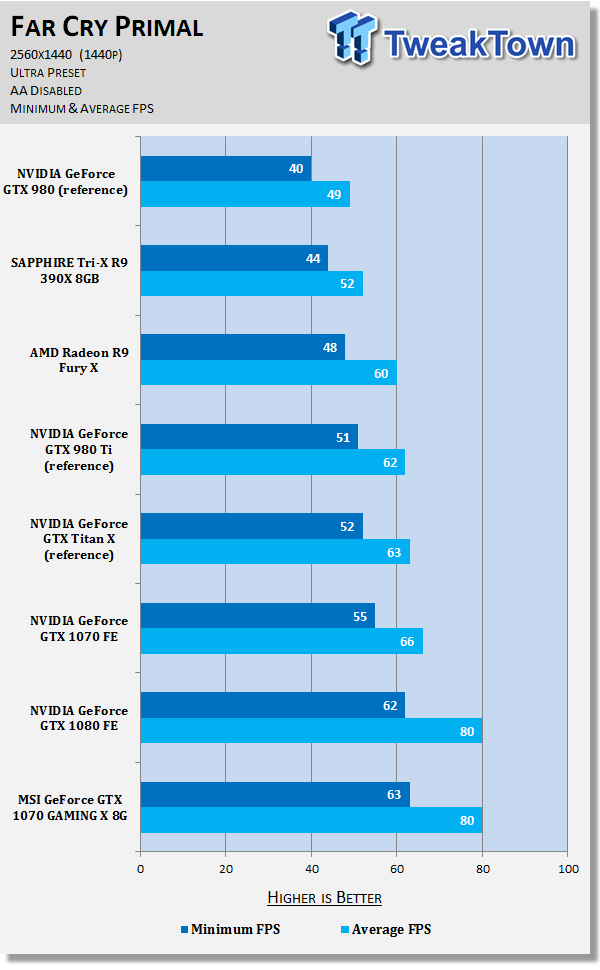

Tom Clancy's The Division is one of the best looking games on the market, build with the beautiful Snowdrop engine. It's an RPG, including some awesome PvP multiplayer, and some of the best graphics on the market. It really stresses systems out, especially at 4K, making it perfect to test with our various video cards.
You can buy The Division at Amazon, and you can read our full review here.
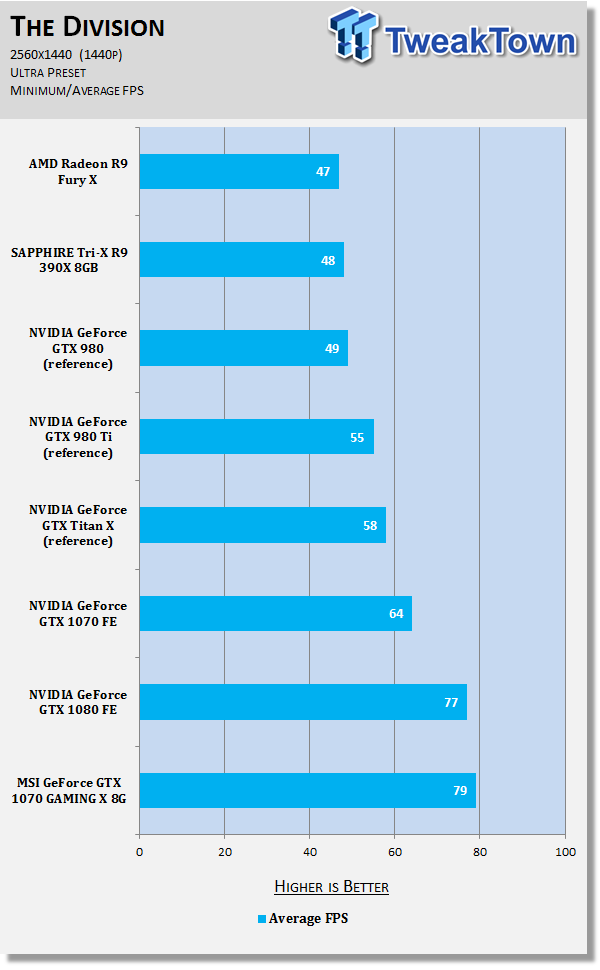

We recently changed over to Metro: Last Light Redux, with developer 4A Games making the Redux version of Metro: Last Light the 'definitive' version of the game. Redux had a fresh coat of paint on the already impressive 4A Engine, and it really pushes our GPUs to their limits.
You can buy Metro: Last Light Redux at Amazon.


Middle-earth: Shadow of Mordor is one of the most graphically intensive games we test, with Monolith using their own Lithtech engine to power the game. When cranked up to maximum detail, it will chew through your GPU and its VRAM like it's nothing.
You can buy Middle-earth: Shadow of Mordor at Amazon.


Thief has been around for quite a while now, with the latest version of the first-person stealth game powered by Epic Games' older Unreal Engine 3. While it's old, it has some great multi-GPU scaling that we use to test out our various GPU setups.
You can buy Thief at Amazon.


Tomb Raider is still such a gorgeous game, with developer Crystal Dynamics using their own 'Foundation' engine to build Lara Croft into the new world. One of the best parts about Tomb Raider is the absolutely stellar multi-GPU scaling, so this is an important test to see how well our NVIDIA GeForce SLI and AMD Radeon Crossfire setups scale.
You can buy Tomb Raider at Amazon.

Benchmarks @ 4K
4K Benchmarks

Far Cry Primal is a game built on the impressive Dunia Engine 2 with wide open, beautiful environments. It might look stunning, but the performance is actually quite good - but most cards will be stressed at 1440p, and especially so at 4K and beyond.
You can buy Far Cry Primal at Amazon.


Tom Clancy's The Division is one of the best looking games on the market, build with the beautiful Snowdrop engine. It's an RPG, including some awesome PvP multiplayer, and some of the best graphics on the market. It really stresses systems out, especially at 4K, making it perfect to test with our various video cards.
You can buy The Division at Amazon, and you can read our full review here.


We recently changed over to Metro: Last Light Redux, with developer 4A Games making the Redux version of Metro: Last Light the 'definitive' version of the game. Redux had a fresh coat of paint on the already impressive 4A Engine, and it really pushes our GPUs to their limits.
You can buy Metro: Last Light Redux at Amazon.


Middle-earth: Shadow of Mordor is one of the most graphically intensive games we test, with Monolith using their own Lithtech engine to power the game. When cranked up to maximum detail, it will chew through your GPU and its VRAM like it's nothing.
You can buy Middle-earth: Shadow of Mordor at Amazon.


Thief has been around for quite a while now, with the latest version of the first-person stealth game powered by Epic Games' older Unreal Engine 3. While it's old, it has some great multi-GPU scaling that we use to test out our various GPU setups.
You can buy Thief at Amazon.
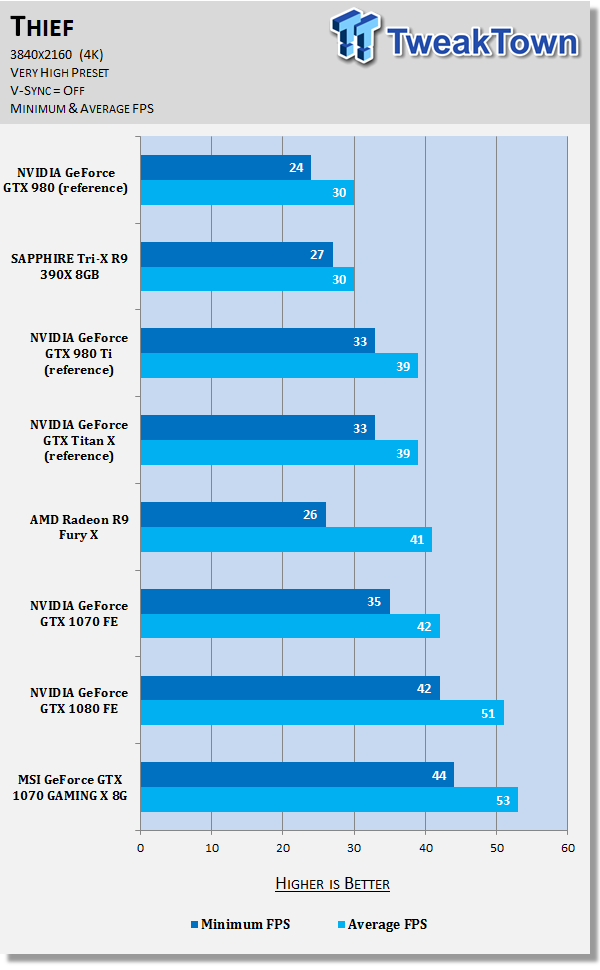

Tomb Raider is still such a gorgeous game, with developer Crystal Dynamics using their own 'Foundation' engine to build Lara Croft into the new world. One of the best parts about Tomb Raider is the absolutely stellar multi-GPU scaling, so this is an important test to see how well our NVIDIA GeForce SLI and AMD Radeon Crossfire setups scale.
You can buy Tomb Raider at Amazon.
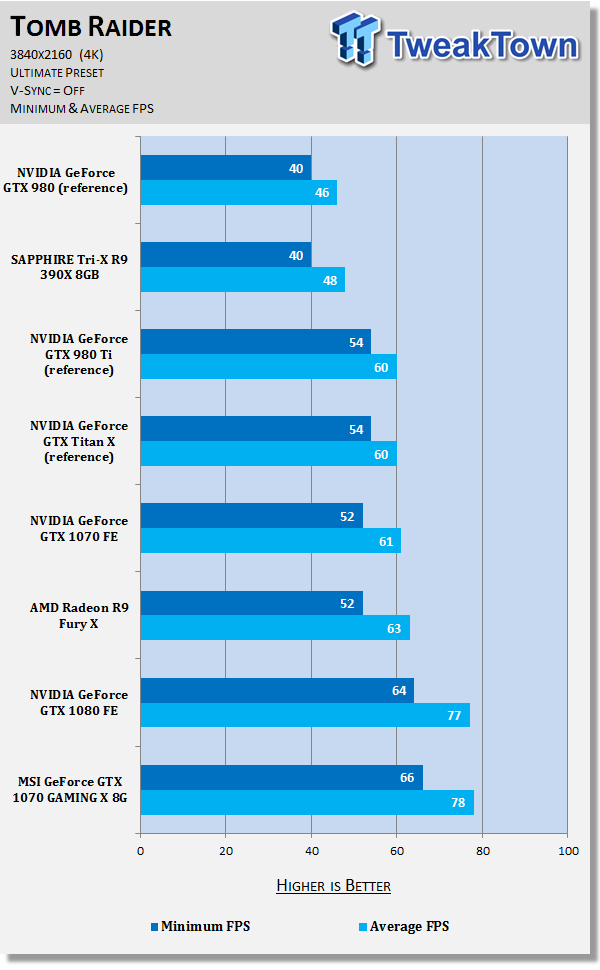
Benchmarks - DX12 & OC Adventures
This is our new section for video card reviews, with DX12 and VR becoming a huge deal over the course of the last 12 months. We have just a handful of DX12 tests right now, so expect this section of the site and our reviews to grow considerably over the coming months.
The same goes for VR, where we have both the Oculus Rift and HTC Vive in house now. We will be testing VRMark for now, which is in Preview form, as well as our thoughts on VR gaming on the HTC Vive with the new GeForce GTX 1080 video card.
DirectX 12 Performance
We have Ashes of the Singularity with DirectX 12, with some impressive results from NVIDIA's latest video card.



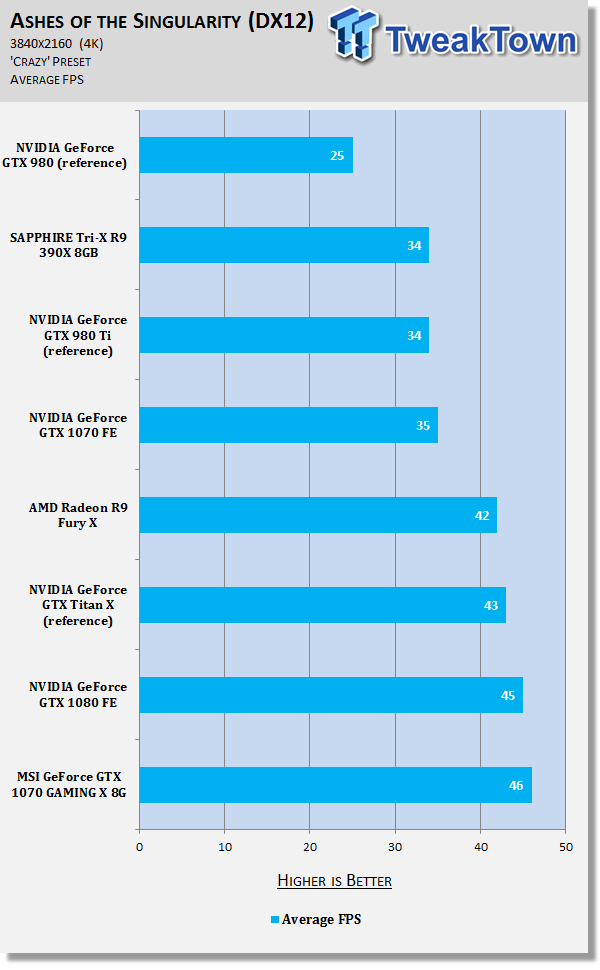
Overclocking Adventures - Near GTX 1080 Performance
With some great tweaking to the MSI GeForce GTX 1070 Gaming X 8G, I was achieving some nice results overclocked. I was able to get our sample up to 2070MHz Boost, while the overclocked card in our test bed using around 285W of power. We also applied 500MHz more pressure to the 8GHz RAM.
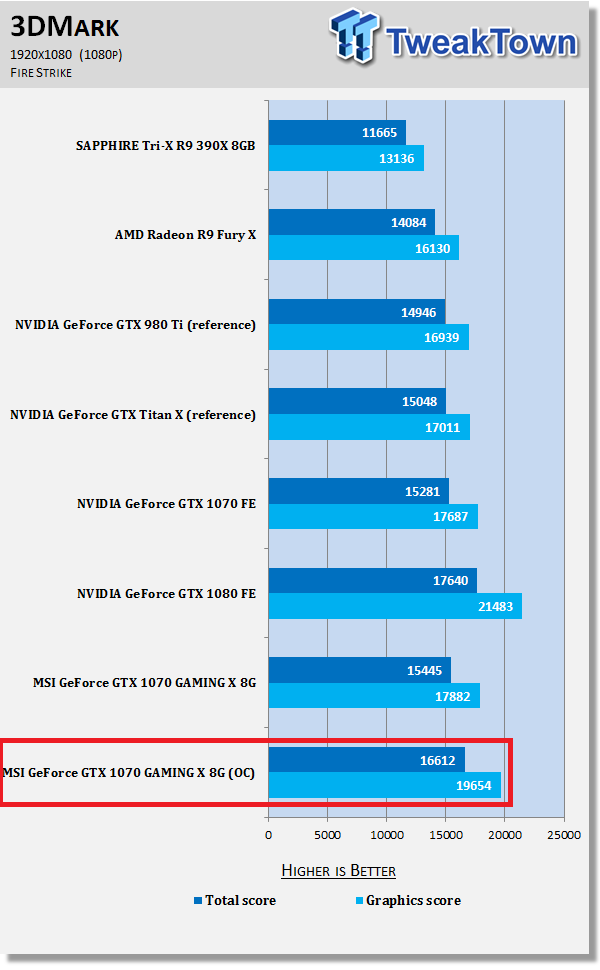

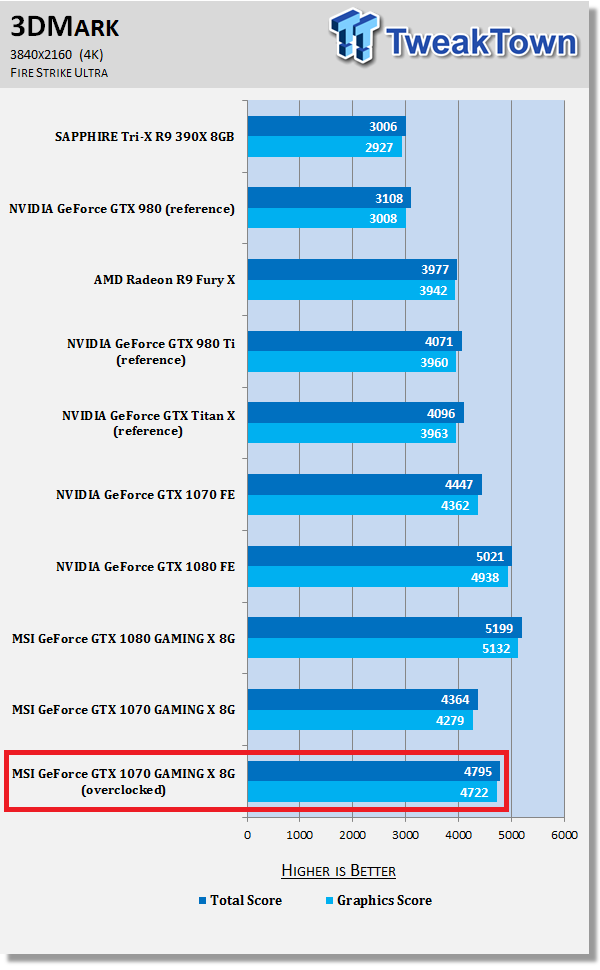
The overclocked card performs well, where it gets close to the performance of NVIDIA's GeForce GTX 1080 Founders Edition. Not bad for a card that's $200+ cheaper.
Power, Temperature, & Noise
Full System = 250W Under Load!
With the additional 6-pin PCIe power connector, the MSI GeForce GTX 1070 Gaming X 8G in our test system powered by an Intel Core i7-5960X processor, Corsair AX1500i PSU and more, consumed 250W. This is right in line with the 250W used by MSI's GeForce GTX 1080 Gaming X 8G, and is one of the most efficient video cards I've ever tested - especially when it comes to price/performance ratio.
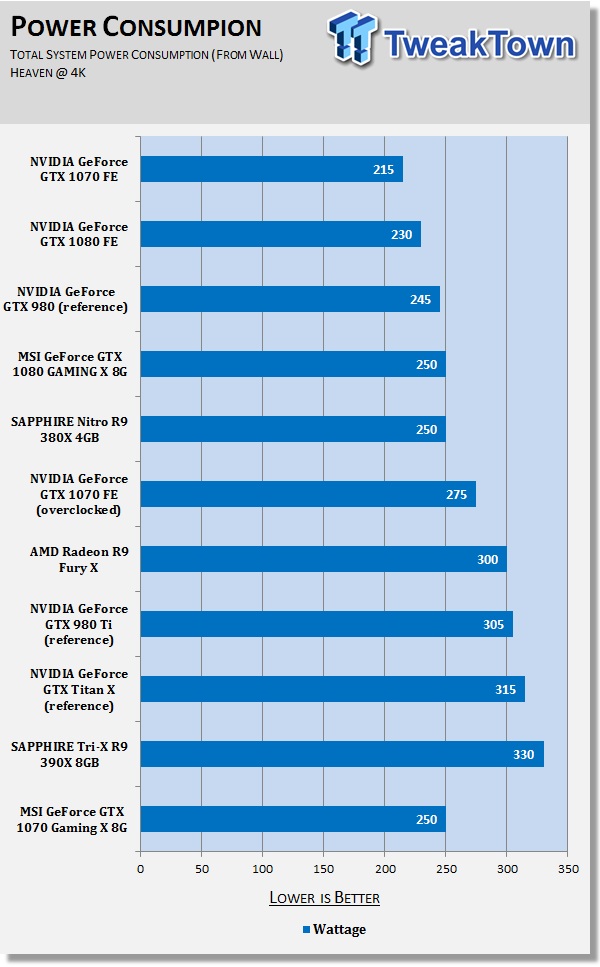
Temperature & Noise

One of the things I praised from the top of mountain peaks - well, from my keyboard at least - was the acoustic performance of MSI's GeForce GTX 1080 Gaming X 8G. Thanks to the new Twin Frozr VI cooler, it was completely silent during our 100% GPU loads. The same goes for the GTX 1070 Gaming X 8G, which is also silent under load - and barely hitting 67C while being thrown under the bus that is our benchmark suite.
Final Thoughts
I was already impressed with what MSI did with their GeForce GTX 1080 Gaming X 8G, and the same applies here. I could pretty much copy/paste the entire review for the most part, except for the price/performance discussion, which we'll have now. Right now, MSI's GeForce GTX 1070 Gaming X 8G is listed on Amazon for $570 or so, with delivery expected between July 1-8, depending on where you purchase it from.

At $150 cheaper (even with the amped up pricing) than the GTX 1080 Gaming X 8G, the GTX 1070 Gaming X 8G represents amazing performance per dollar. With performance that rivals the GTX 1080 Founders Edition, and sometimes even beats it, the MSI GeForce GTX 1070 Gaming X 8G represents even better value for money than its bigger and sometimes faster big brother. The GTX 1080 is an amazing card, don't get me wrong, but performance per dollar is very important, too.
This is where MSI paints a great picture with their GeForce GTX 1070 Gaming X 8G, as we have near GTX 1080 levels of performance, for $200 less - and then some overclocking headroom which provides, even more, value for money. Where can you go wrong? The Twin Frozr VI cooler keeps the entire card nice and cool under those all-night gaming sessions, and better yet, it's completely silent under load, just like its more expensive sibling.
Do I recommend MSI's GeForce GTX 1070 Gaming X 8G? Hell yes. It's a fantastic video card for the price, with silent operation and a slick look that MSI continues with from previous generation cards. MSI hasn't stepped wrong with the GeForce 10 series yet!

| Performance (overclocking, power) | 95% |
| Quality (build, design, cooling) | 100% |
| General Features (display outputs, etc) | 95% |
| Bundle, Packaging & Software | 100% |
| Value for Money | 95% |
| Overall | 97% |
The Bottom Line: MSI hits yet another home run with the GeForce GTX 1070 Gaming X 8G, a silent card that smashes the price/performance barriers.
PRICING: You can find products similar to this one for sale below.
 United
States: Find other tech and computer products like this
over at Amazon.com
United
States: Find other tech and computer products like this
over at Amazon.com
 United
Kingdom: Find other tech and computer products like this
over at Amazon.co.uk
United
Kingdom: Find other tech and computer products like this
over at Amazon.co.uk
 Australia:
Find other tech and computer products like this over at Amazon.com.au
Australia:
Find other tech and computer products like this over at Amazon.com.au
 Canada:
Find other tech and computer products like this over at Amazon.ca
Canada:
Find other tech and computer products like this over at Amazon.ca
 Deutschland:
Finde andere Technik- und Computerprodukte wie dieses auf Amazon.de
Deutschland:
Finde andere Technik- und Computerprodukte wie dieses auf Amazon.de
What's in Anthony's PC?
- CPU: Intel Core i5-12600K
- MOTHERBOARD: GIGABYTE Z690 AERO-G
- RAM: Corsair 32GB DDR4-3200
- GPU: NVIDIA GeForce RTX 4090 24GB
- SSD: Sabrent 4TB Rocket 4 Plus
- OS: Windows 11 Pro
- CASE: Lian Li O11 Dynamic XL
- PSU: ASUS ROG Strix 850W
- KEYBOARD: Logitech G915 Wireless
- MOUSE: Logitech G502X Wireless
- MONITOR: LG C3 48-inch OLED TV 4K 120Hz
Similar Content
Related Tags

